Watershed Hydrology
The Mt. Mansfield Paired Watersheds Study
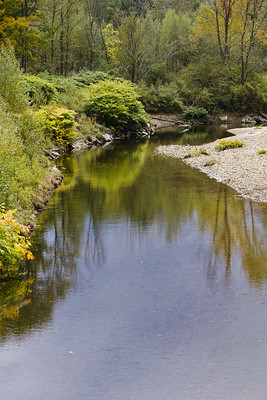
Since September 2000, the U.S. Geological Survey (USGS) has been continuously operating stream gauges at Ranch Brook and West Branch near Stowe, Vermont (Wemple et al., 2007). The gauging was designed as a paired watershed study, with Ranch Brook (watershed size 9.6 km2) as the forested control watershed, and West Branch (11.7 km2) as the developed watershed. The West Branch watershed contains nearly the entire extent of the four-season Stowe Mountain Resort. In the classic paired watershed approach, monitoring would have been conducted prior to any development, but the resort was established long before the study began.
However, the resort underwent a significant expansion during the course of the study, so the study design is appropriate to assess the effect of the expansion. This report on the Mt. Mansfield gauging is for Water Year (WY) 2018 (October 1, 2017 through September 30, 2018). The report interprets the WY18 streamflows in the context of the full 18-year record. Historic and near real-time streamflow data are available on the USGS website (links have been provided in the additional resources section following this report).
In WY18, the gauges were jointly funded through a cooperative agreement between the USGS, the Vermont Department of Environmental Conservation and the Forest Ecosystem Monitoring Cooperative (FEMC). The gauges provide valuable information on mountain hydrology in Vermont, and how mountain landscapes respond to development and extreme events. To our knowledge, these are still the only gauged watersheds at a ski resort. The gauges have supported projects on snow hydrology and water quality by the University of Vermont (UVM), Sterling College, Vermont Agency of Natural Resources, and others. In particular, Beverley Wemple and students at UVM have used the gauges as a base for student projects and hands-on learning, and to attract additional funding for value-added research.
The Data
Stream gauges on Ranch Brook and West Branch provide continuous monitoring of stream water heights (stage), which are related to discharge (flow) by an empirical rating based on frequent discharge measurements. This information provides a basis for the monitoring of long-term hydrology patterns and water quality trends including: baseline conditions, trends in stream acid/base status, cations (Ca2+, K+, Mg2+, Na+), anions (Cl-, NO3-, SO42-), Si, suspended sediment, snowpack and snowmelt, and extreme climate events. These gauging stations provide a watershed framework for other FEMC efforts including nutrient cycling, forest health assessments, forest fragmentation and biological monitoring.
Discharge vs. runoff
Streamflow, also called discharge, is measured in volume per unit time. In the U.S. it is typically measured as cubic feet per second, or cfs (Figure 33). Throughout this report, we use runoff rather than streamflow.
Runoff is the discharge divided by the area of the watershed, which allows for a direct comparison of the streamflow from watersheds of differing sizes. For example, if one watershed is twice the size of another and has twice the streamflow, the runoff of the two watersheds would be the same. Runoff is reported in depth per unit time -- the same as units precipitation which allows runoff to be directly compared to precipitation. For example, if a watershed receives 1500 mm/yr of precipitation and has 1000 mm/yr of runoff, that means 500 mm/yr was lost to evapotranspiration, plus or minus a change in the amount of water stored in the watershed, e.g. in soils.
Water Year 2018 in Summary
Relative to the 18-year record, WY18 had slightly below average runoff. WY18 featured low runoff in fall and winter, followed by average to slightly below average runoff in spring (Figure 33).
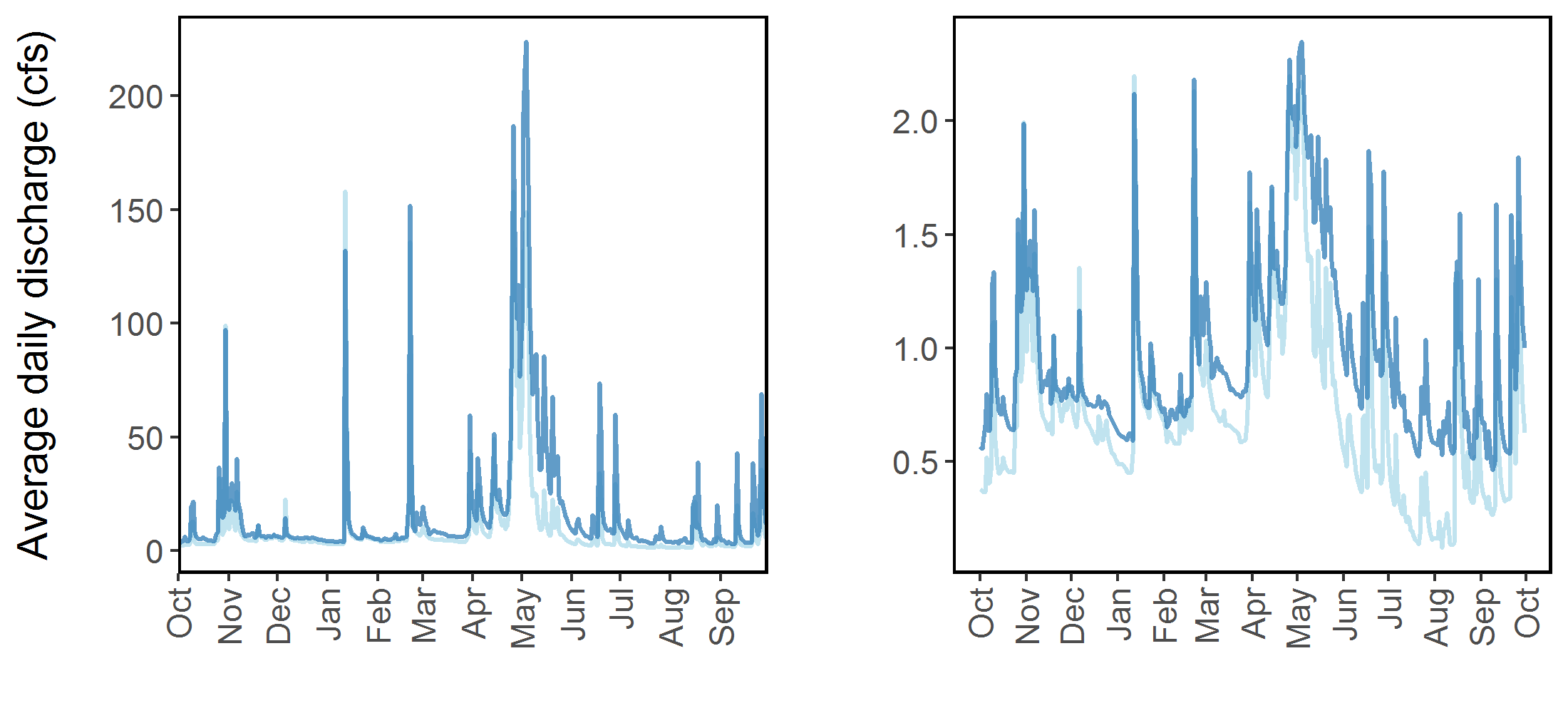
Compared to WY17, in which the cumulative runoff was above average for the most of the year, WY18 remained below average levels throughout the year (Figure 34). Cumulative runoff at both sites peaked in May, reaching average levels. The rest of the water year remained below the average cumulative runoff levels for the 18-year study. The cumulative runoff patterns at the two sites in WY18 were similar to long-term patterns (Figure 34), with both streams generating similar runoff until part way into the spring snowmelt, when West Branch consistently generated greater runoff. Part of the greater snowmelt runoff was from the melting of machine-made snow. (Note that water used for snowmaking at the Stowe Mountain Resort is extracted from West Branch upstream of the gauge, meaning that when the snow melts, the water is not double-counted). Runoff at West Branch continued to exceed that at Ranch Brook through the summer due to higher sustained base flow (Figure 34).
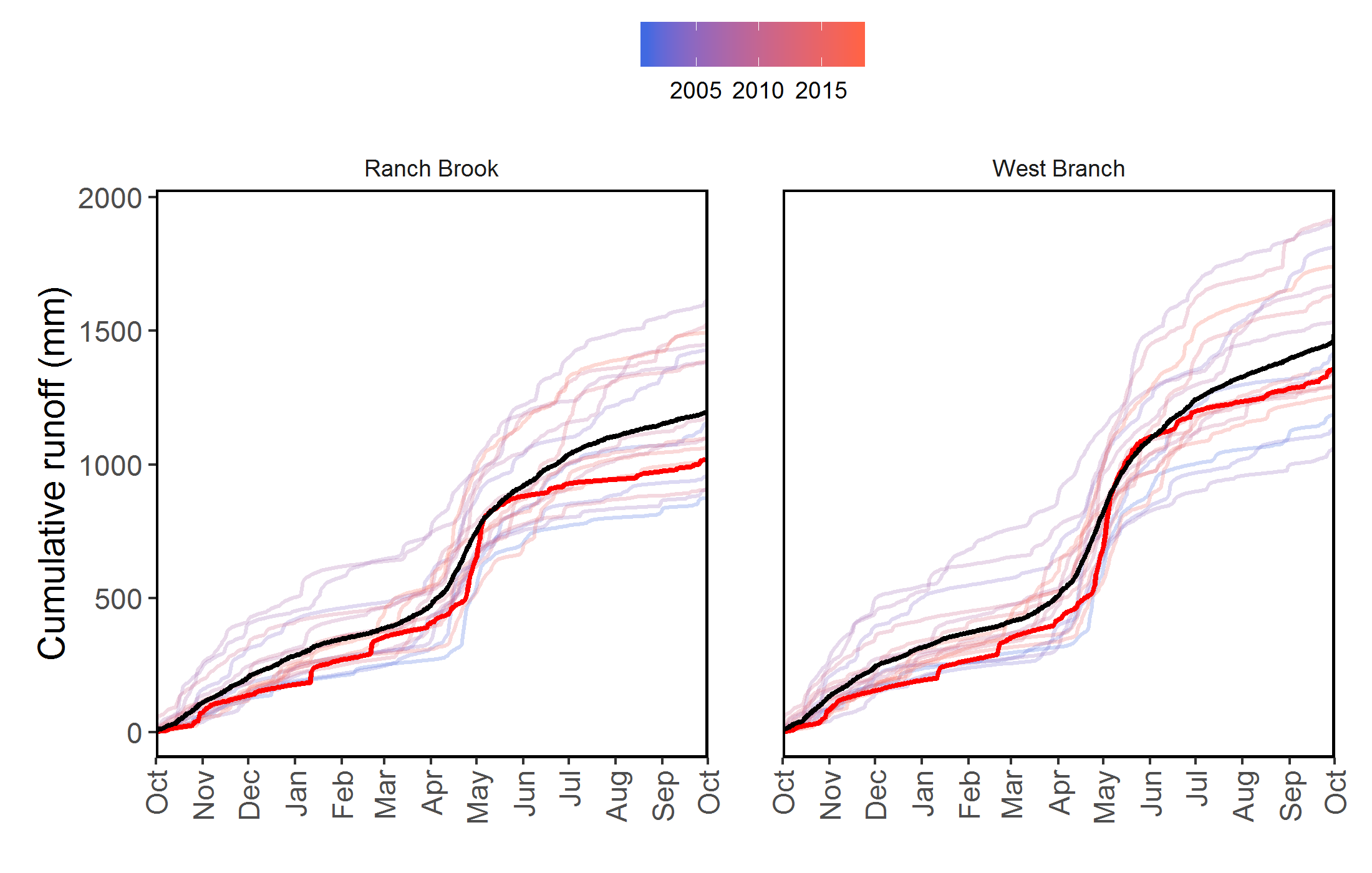
Long Term Trends
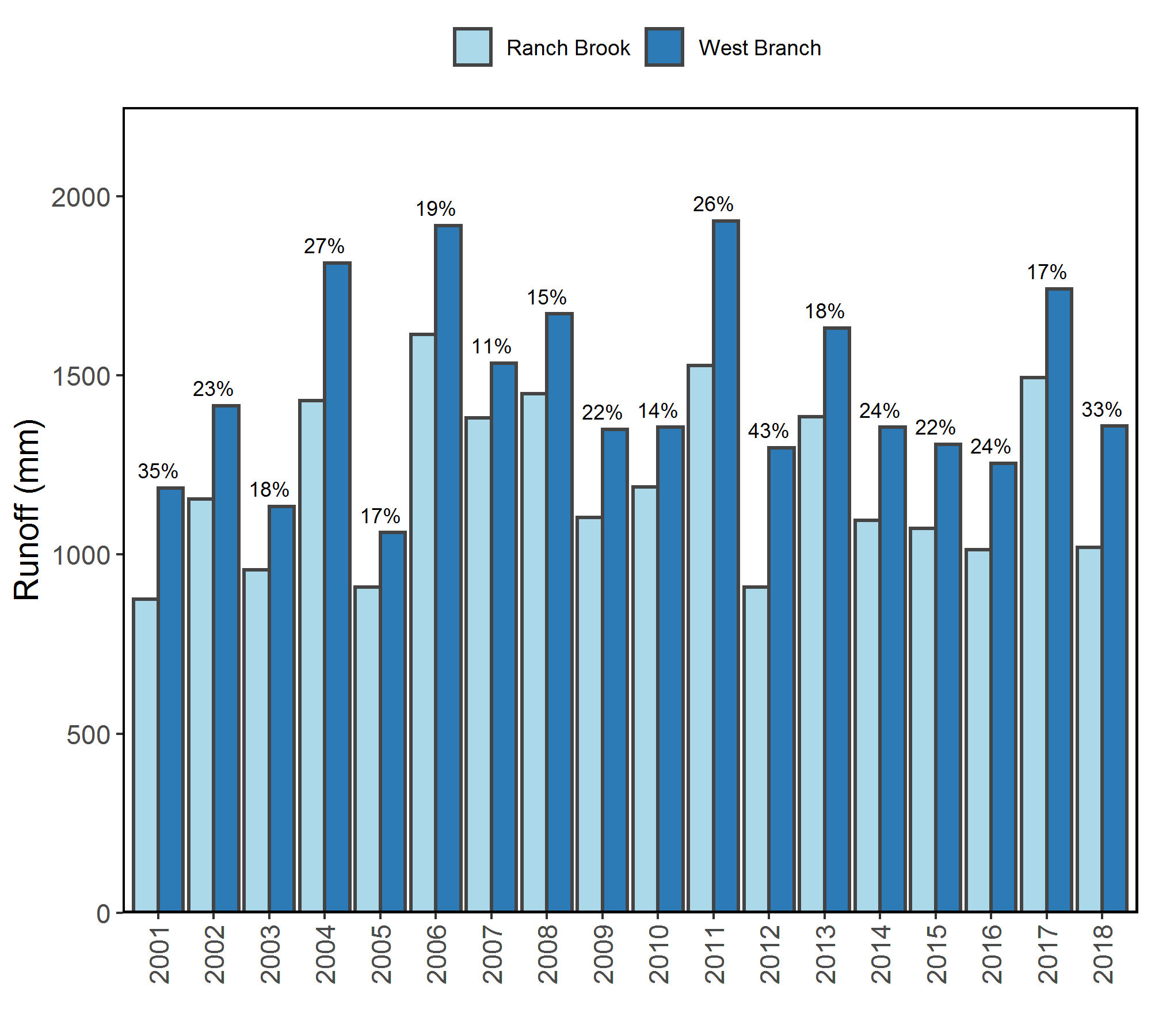
As noted in previous reports, West Branch has consistently yielded higher runoff (flow normalized to watershed area) than Ranch Brook (Wemple et al., 2007) (Figure 34 and Figure 35). Over the long-term, the average difference has been a 23% greater runoff at West Branch. The Water Year 2018 differential was 33%, above the long-term average (Figure 35). Greater runoff at West Branch is what we would expect from the creation of open land and development, however, the high magnitude of the differential suggests that some part of the difference may be natural. In previous reports, we noted the extreme variability of large summer storms; these may preferentially impact West Branch. FEMC cooperators are currently investigating the role of local meteorology on the flow regimes.
In a first step to assess the hydrologic impact of the resort expansion, we constructed flow duration curves for two three-year periods of approximately equal precipitation, from before and after the construction period (Figure 36). Preliminary analysis suggests that the resort build-out had no clear impact on the hydrology, except for the low-flow regime. Construction of a new snowmaking pond with greater storage has lessened the need to draw water directly from the stream at low flows, thus enabling a higher sustained baseflow in late fall and winter.
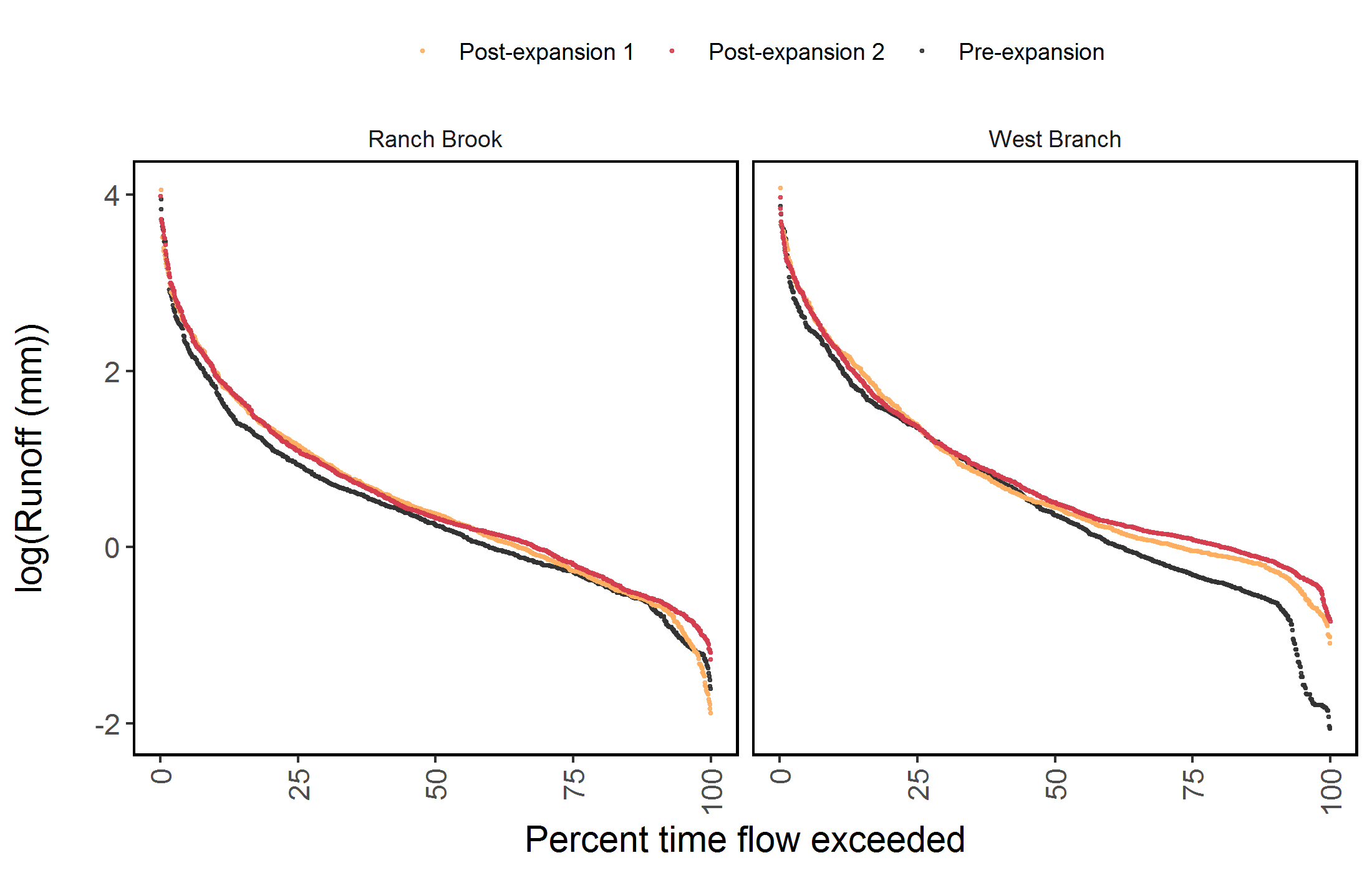
Implications
Mountain ecosystems worldwide are increasingly stressed by development of year-round recreational venues, tourism and other development such as communication towers and wind farms. As ski resorts continue to develop year-round recreation and tourism infrastructure, runoff patterns, volume, velocity, and chemical make-up may change as a result. Additionally, climate change will likely disproportionally affects higher elevation ecosystems with warming temperatures and fewer, more intense precipitation events which are increasingly in the form of rain rather than snow.
Climate models predict more extreme precipitation events (already evident) that can potentially flood mountain streams, leading to erosion, loss of stream bank cover and scouring of stream bottoms, causing major disruptions to fish and macroinvertebrate habitat, increased sedimentation and water temperature (if cover is lost) and changes in essential stream nutrient and oxygen concentrations. Conversely, extended periods of low flows (drought conditions), whether naturally-occurring or human induced (e.g., water for hotels and residences and snow making), can also adversely affect both aquatic and riparian animal and plant communities.
This study provides valuable information, quantifying differences in overall streamflow volumes, peak flows, minimum flows, and timing and duration of each in both an undeveloped and a developed watershed at a high elevation. This project has, and will continue, to produce real-world data needed by State regulatory agencies to make data-driven, environmentally sound decisions about development at Vermont’s high elevation sites. Without proper regulatory oversight, safeguards, and controls, alterations in streamflow (quantity, velocities, timing, and water quality) can potentially have devastating impacts on aquatic and riparian communities downstream of highly developed sites.
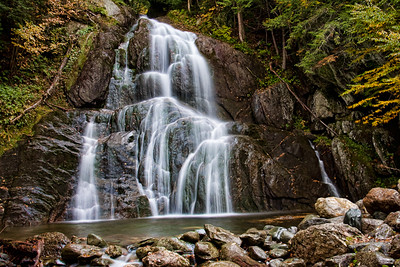
Vermont’s high elevation areas have the potential to be heavily impacted as the result of increased annual use and changing climatic conditions.
References
Wemple, B., J. Shanley, J. Denner, D. Ross and K. Mills. 2007. Hydrology and water quality in two mountain basins of the northeastern US: assessing baseline conditions and effects of ski area development. Hydrological Processes 21(12): 1639-1650.
Additional Resources
Burlington National Weather Service data accessible at:
https://w2.weather.gov/climate/index.php?wfo=btv
Northeast Regional Climate Center, accessible at:
http://www.nrcc.cornell.edu/regional/tables/tables.html
West Branch data are accessible at: http://waterdata.usgs.gov/vt/nwis/uv?site_no=04288225.
Ranch Brook data are accessible at: http://waterdata.usgs.gov/vt/nwis/uv?site_no=04288230.
FEMC Project Database Links
Paired Watershed Study on the East Slope of Mount Mansfield: https://www.uvm.edu/femc/data/archive/project/paired-watershed-study-east-slope-mount
